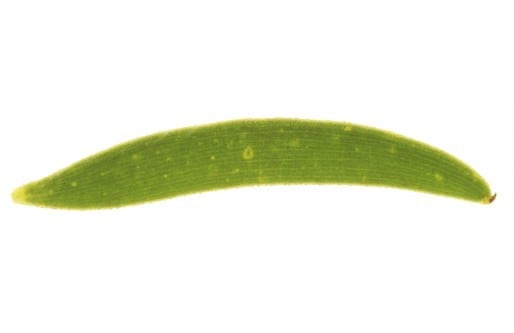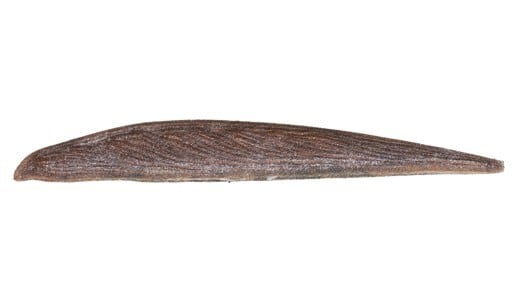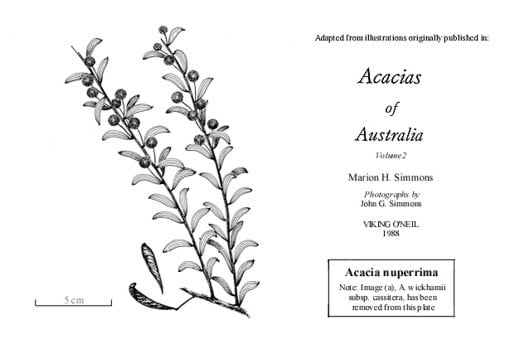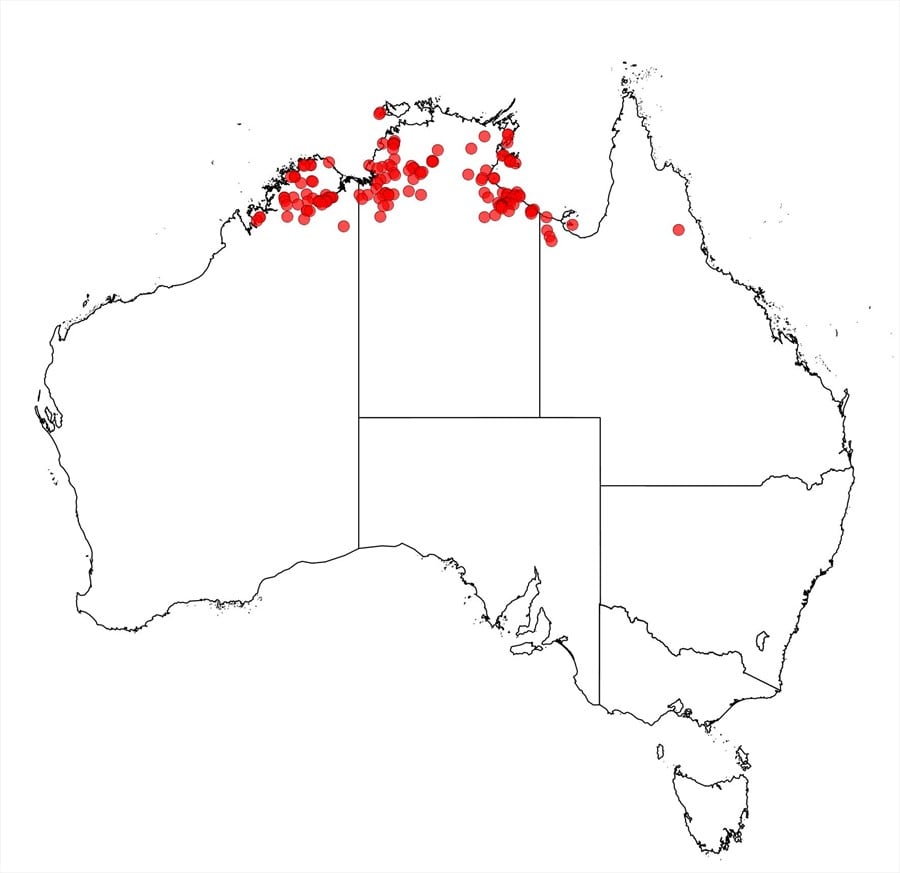Acacia nuperrima Baker f.
WATTLE
Acacias of Australia
Family
Fabaceae
Distribution
Occurs in tropical northern Australia from the Kimberley region of W.A. (especially in the Cape Londonderry, Derby and Fitzroy R. areas) to N.T. (mainly north-western and north-eastern parts) and offshore islands in the Gulf of Carpentaria, into north-western Qld in the Corinda area.
Description
Shrub to 1 (–1.3) m high, erect ascending to semiprostrate, often spreading, glabrous, resinous, often with many slender stems branching at base. Bark smooth to slightly fissured at base, grey or brown. Branchlets angular towards apices with resin-crenulated ridges, finely lenticellate. Phyllodes rather spreading, narrowly elliptic to very narrowly elliptic, sometimes slightly wider below middle or ±linear, ±flat or sometimes slightly undulate, shallowly to markedly ±downwardly curved and often slightly sigmoid to sometimes straight, (0.4–) 0.7–2 (–3.5) cm long, (1–) 1.5–3 (–5) mm wide, coriaceous; nerves obscure or rarely midnerve and 2 lateral nerves scarcely conspicuous; lamina finely longitudinally wrinkled to appearing striate; apex with an oblique small (beak-shaped) mucro (hooked apiculate); gland absent or 1 minute basal gland to 1 (–2) mm above pulvinus. Peduncles 5–15 (–20) mm long, 0.4–0.6 mm wide. Heads 4–7 mm diam., 10–20 (–23)-flowered, yellow to golden, sometimes paler; bracteoles with triangular acute to acuminate lamina, mostly about same length or slightly longer than flower calyces; buds spreading. Flowers 5-merous; calyx cupular, 0.7–1 mm long, dissected to 1/10–1/5, reddish papillose towards apex; corolla 1.5–2 mm long, dissected by ½ or more. Pods erect, narrowly oblanceolate to ±linear, straight-sided, 2.5–5.5 (–6.5) cm long, 3–5 (–7) mm wide, obliquely nerved; margins subprominent. Seeds narrowly oblong-elliptic, 2.7–5 mm long, brown; funicle-aril narrowly conical.
Phenology
Flowers Jan.–Oct.
Habitat
Grows in sandy, rocky, sandy clay, lateritic or red loam soils, on plains, ridges or in undulating country, in shrubland, low open woodland, savannah woodland or sometimes open forest, often with eucalypts or Melaleuca.
Specimens
W.A.: 55 km E of Durack R., D.Keith & B.Pellow 226 (NSW, PERTH, SYD). N.T.: Stuart Hwy towards Borroloola, C.H.Gittins 2468 (BRI, DNA, NSW); 3 miles [4.8 km] SSW of Bing Bong Stn HS, N.M.Henry 123 (DNA, NSW); 33 km W of Borroloola, M.O.Parker 967 (CANB, DNA, NSW); Centre Is., Pellew Is. Group, B.Rice 2034 (K, NSW, Z). Qld: Corinda Stn, C.H.Gittins 1269 (BRI, NSW, PERTH).
Notes
A variable species, especially in the size and shape of the phyllodes, from variably curved-sigmoid phyllodes to long, slightly curved to straight phyllodes. The latter appear to be common in the Groote Eylandt to north-eastern Arnhem Land region, N.T., e.g. N.Byrnes 959 (BRI), I.Cowie 2034 & Brocklehurst (BRI, DNA, MEL, NSW), R.L.Specht 582 (BRI, NSW). Some phyllodes may rarely have a setose mucro similar to that of A. setulifera (e.g. Blake 16312, BRI), but this may be a feature usually lost with age.
There is a possible variant approaching A. setulifera in the Timber Creek area, N.T. (see A. setulifera notes). Some specimens (especially from the ‘Oobagooma’/Mitchell Plateau area in northern W.A.) are difficult to distinguish from A. translucens and have bracteoles similar to those found in the latter. Further studies of this group are required.
Acacia nuperrima is closely allied to A. setulifera which has smaller, rounded phyllodes with a prominent, fine, apical mucro (setose point), and to A. translucens which generally has wider phyllodes and more flowers per head. Also related to Acacia sp. Kununurra (G.Lullfitz 6195) and A. stellaticeps in the ‘A. stigmatophylla group’. Differences between A.nuperrima and A. producta, also in this group, are described by M.D.Tindale, Telopea 2: 119 (1980). Phyllodes sometimes superficially similar to those of A. wickhamii subsp. cassitera.
FOA Reference
Data derived from Flora of Australia Volumes 11A (2001), 11B (2001) and 12 (1998), products of ABRS, ©Commonwealth of Australia
Author
P.G.Kodela
Minor edits by B.R.Maslin
This identification key and fact sheets are available as a mobile application:
URL: https://apps.lucidcentral.org/wattle/
© Copyright 2018. All rights reserved.














